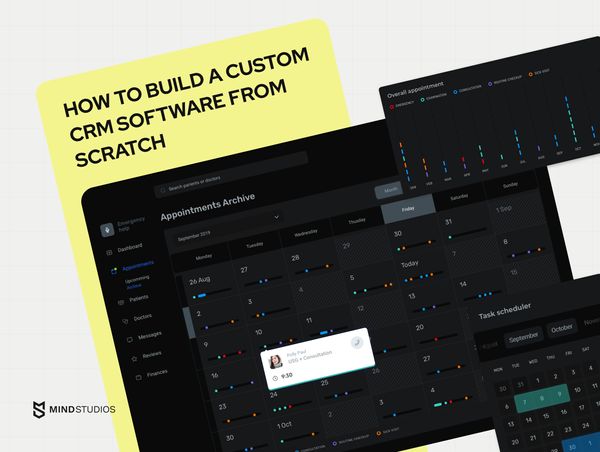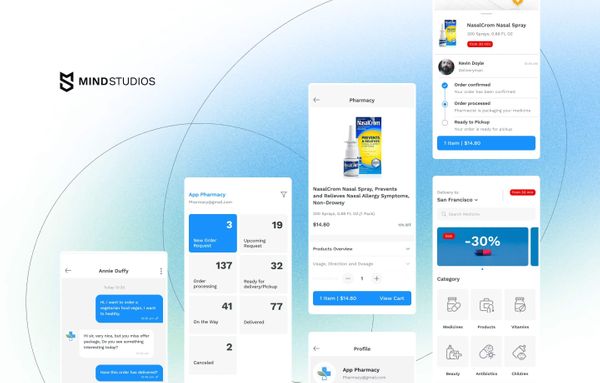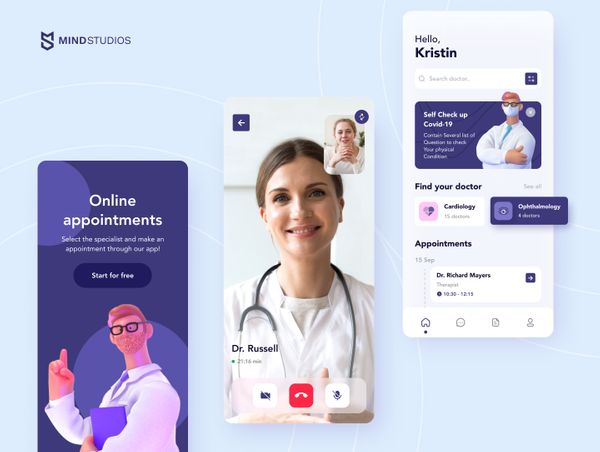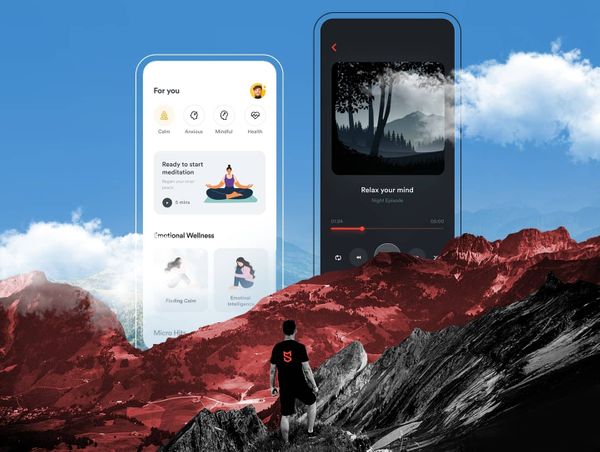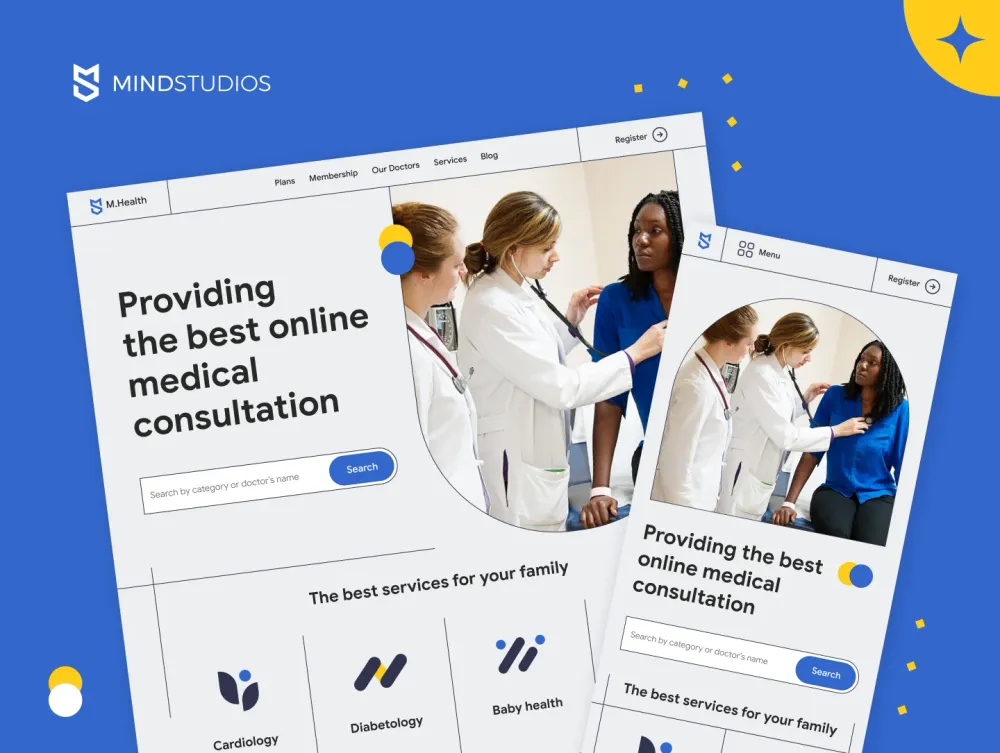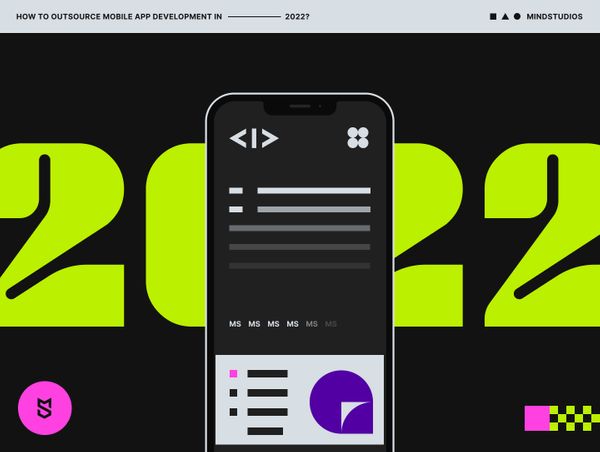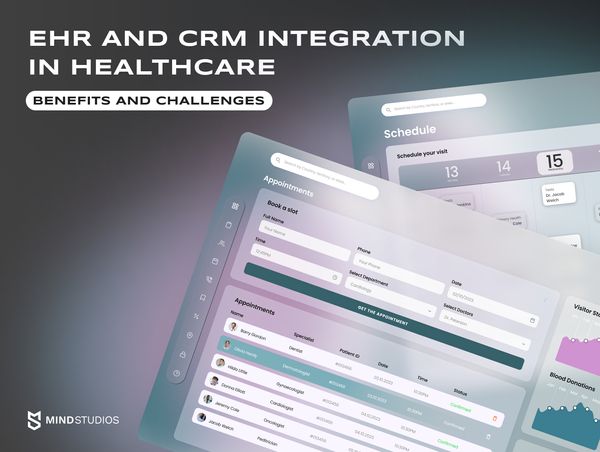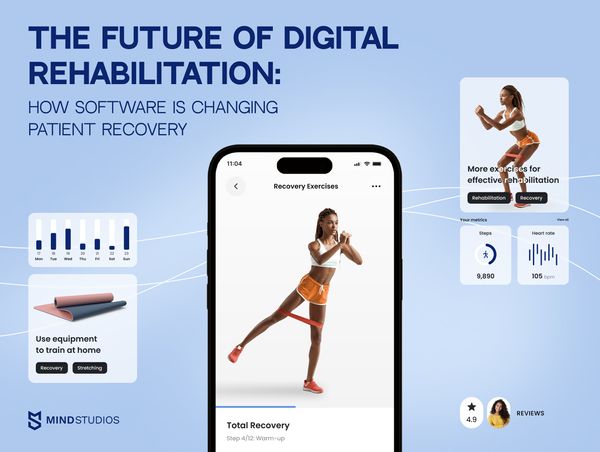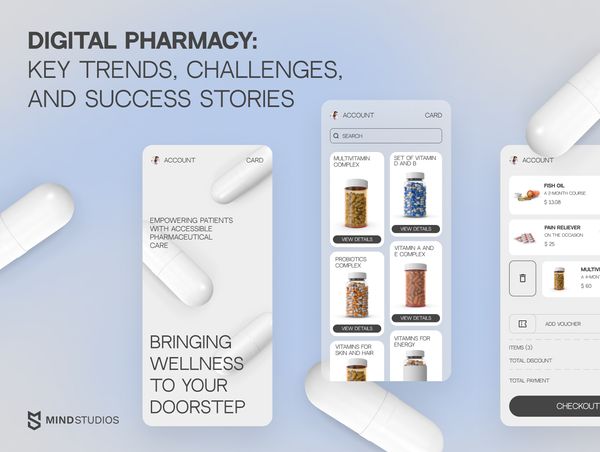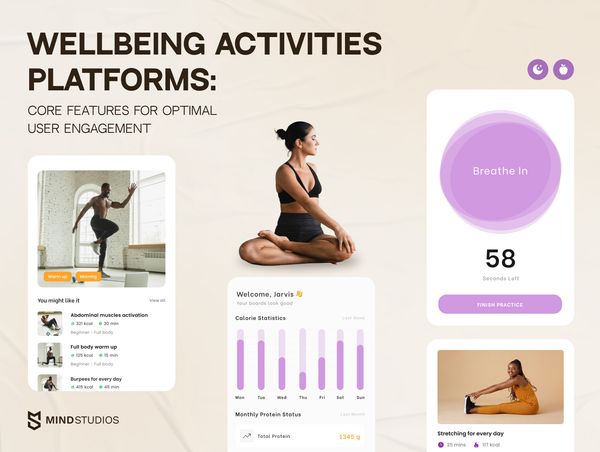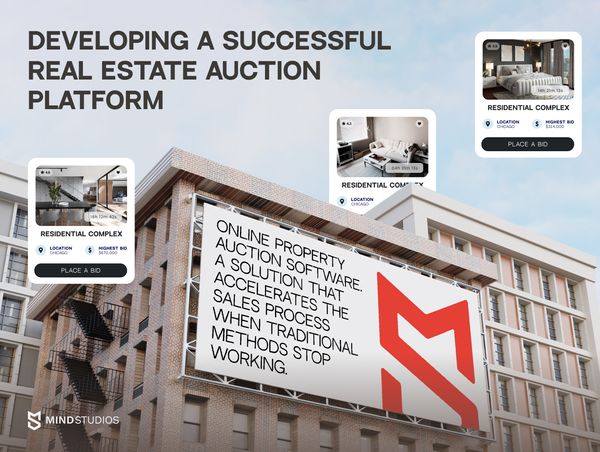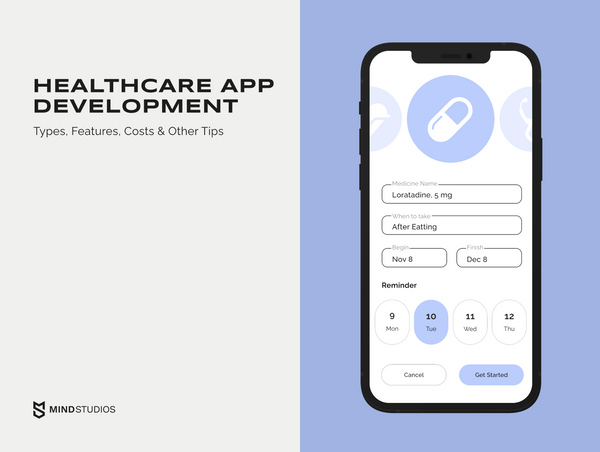
Rising focus on personal health and wellness, rapid evolution in technology, and the critical need for accessible healthcare are just a few factors that have triggered a surge in healthcare app development. Now that more doctors and patients than ever are on board with using mHealth apps, it might be high time to build a product that meets their needs.
So, why does the mHealth app market look so promising today? How to make a healthcare app and what to consider? What does the tech side of the development look like? And how much does it cost to build a medical app?
Here, we provide extensive answers to each of these questions and share Mind Studios’ experience of creating an app that assists people with chronic illnesses and injuries.
Growth of the healthcare mobile app market
Digitalization has influenced nearly every area of our lives, including healthcare. Today, you can schedule an appointment with your physician, get blood test results, and even have a mental health therapy session all through a mobile application. So, how big is the healthcare app market?
According to a report published on Grand View Research, the value of the global mHealth apps market size reached USD 38.2 billion in 2021, and is expected to grow at a CAGR (a compound annual growth rate) of 11.8% from 2022 to 2030. North America is dominating the healthcare app market, accounting for 38.2% of the revenue share in 2021.
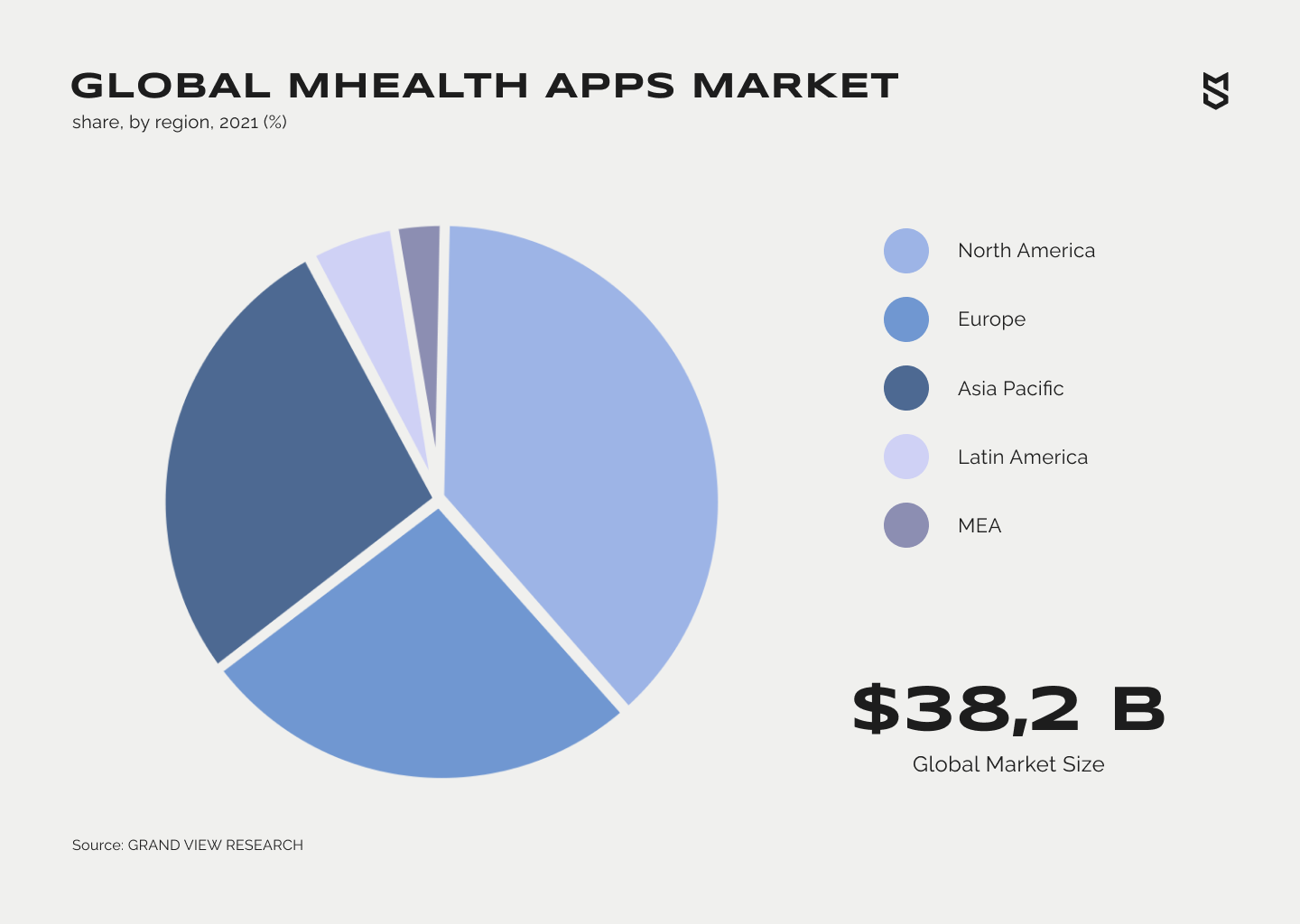
What is more, as stated in a report by IQVIA Institute for Human Data Science, there are over 350,000 digital health applications available on app stores. This number includes medical as well as general wellness and fitness apps.
The main reasons for the growth of the healthcare app market are:
- Rapid increase of smartphone and internet users
- The prevalence of chronic illnesses that require constant care
- Promotion of mHealth applications by the government and healthcare professionals in certain regions, like the US
- Increasing awareness of the importance of maintaining a healthy lifestyle
Finally, it’s no surprise that the COVID-19 pandemic triggered a surge in creating new digital medical tools, including mobile app development for healthcare. So, if you decide to build a healthcare app and choose the right team to do it, you have high chances of succeeding.
Difference between a health app and a medical app
It’s easy to confuse health apps and medical apps since they are often used interchangeably. However, there is a clear difference, so let’s get into it.
Health apps are mobile platforms designed to promote general well-being, fitness, and healthy lifestyle choices, as well as assist users with maintaining them. Such apps offer features that allow people to track and manage aspects of their health, such as physical activity, nutrition, sleep, mental well-being, and so on.
Health apps also often focus on encouraging users to develop healthy habits by enabling progress tracking and providing valuable insights into users’ overall wellness. Examples of such apps include MyFitnessPal, Headspace, and Strava.
Medical apps, on the other hand, usually have a direct connection to medicine and healthcare. They aim to provide users with specific medical information and tools for diagnosis, treatment, or health conditions management.
Medical apps need to comply with legal data privacy and security regulations, as well as adhere to medical guidelines. Medical apps can include products like symptom checkers, medication management apps, telemedicine platforms, medical reference apps, and more. Examples of medical apps include Medscape and Epocrates.
Types of healthcare apps
Depending on the type of services you provide, you need to choose the type of app that will serve your needs best. Here, we’ve collected the 6 most common healthcare app types on the market.
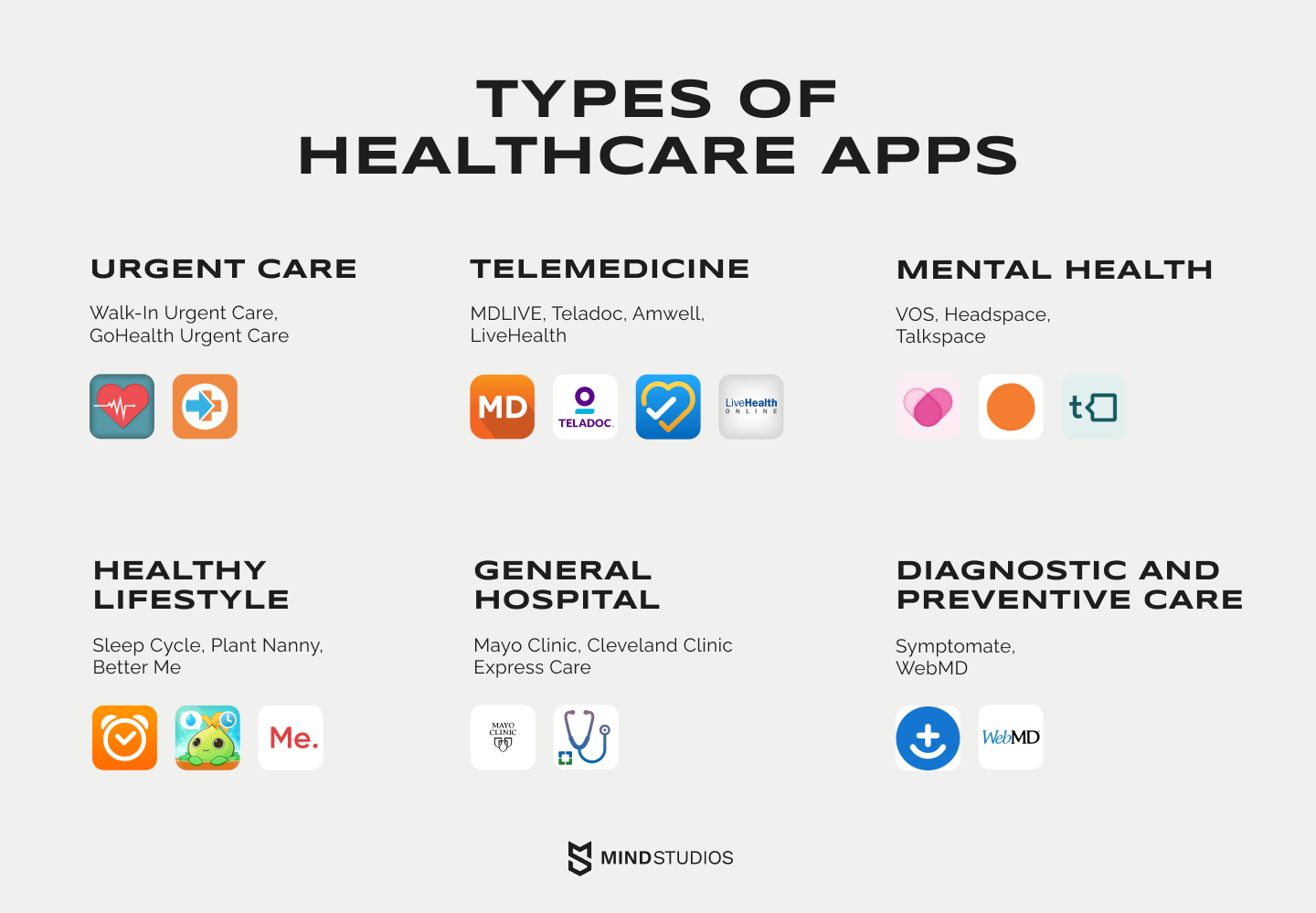
1. Urgent care apps
Also called ER platforms, these apps are aimed at helping people in emergency situations get the help they need. Typically, such apps provide directions to the nearest emergency departments for those with and without medical insurance, as well as show travel and waiting time.
Among the most common features of urgent care apps are:
- GPS tracker
- cost estimate calculator
- contact base of emergency departments
- emergency contacts, like contact numbers of close family members
Additionally, these apps can provide basic instructions that can assist people who are witnessing an emergency situation in providing primary medical assistance to the patient. For instance, they can guide the bystanders through helping a person having a seizure.
Examples: Walk-In Urgent Care, GoHealth Urgent Care
2. General hospital apps
Healthcare apps that are run by general hospitals help to improve their communication with patients and even serve as a promotional tool.
Must-have features of general hospital apps include:
- electronic health record (EHR) integration
- doctors’ profiles and their availability
- patients’ profiles where they can receive their lab reports or e-prescriptions
- list of treatments and services the hospital provides
- emergency room waiting time
Additionally, some hospital apps can focus specifically on appointment management. This functionality usually includes calendars where both patients and healthcare professionals can track upcoming visits and medical procedures. Virtual appointments via audio or video calls are also essential in the post-pandemic era.
Keep in mind that hospital app development usually requires partnering up with medical facilities in order to create a truly helpful product that works in real-life environments.
Examples: Mayo Clinic, Cleveland Clinic Express Care
3. Diagnostic and preventive care apps
The focus of these apps is diagnostic medicine, meaning they provide patients with access to personal medical history and medical test results, as well as give an opportunity to schedule new tests. They also can include symptom checkers that help patients determine which tests they need to take and which professionals they should see.
Standard features of diagnostic apps are:
- electronic health record (EHR) integration
- medical test scheduling, costs, and lab results
- symptom checker or AI-powered diagnosis assistant
- appointment management
- guides and useful information on chronic illness management and living a healthy lifestyle
Examples: Symptomate, WebMD
4. Telemedicine apps
Often referred to as doctor-on-demand apps, these platforms are created to provide healthcare services remotely. Usually, it means the doctor and the patient communicate via text, audio, or video channels.

The main features of telemedicine apps are:
- electronic health record (EHR) integration
- patients’ profile and dashboard
- doctors’ profile with ratings and reviews
- appointment management
- text, audio, or video chats
- e-prescriptions
- payment gateway
Telemedicine apps can also be based on Internet-of-Things technologies. This means the patients can use additional devices for measuring blood pressure, sugar level, and other vital signs that get sent to a doctor for a more effective treatment.
Examples: MDLIVE, Teladoc, Amwell, LiveHealth
5. Healthy lifestyle apps
The number of subcategories for this type of app is countless. Such mobile platforms can help you track your water and calorie intake, the number of steps daily, and the quality of sleep. Some also remind users to have regular medical checkups. The goal is to motivate users to make a habit of healthy living and prevent health problems.
Though the main features depend on the app’s goals, the most common ones include:
- users’ profiles with data like level of activity, weight, medical conditions, etc.
- habit tracking
- push notifications
- guides on proper nutrition or sports activities
Examples: Sleep Cycle, Plant Nanny, Better Me
6. Mental health apps
Helping with managing any mental health condition is what these apps are for. Whether it’s anxiety, depression, or eating disorders — mental health apps provide patients with tools to monitor and enhance their progress.
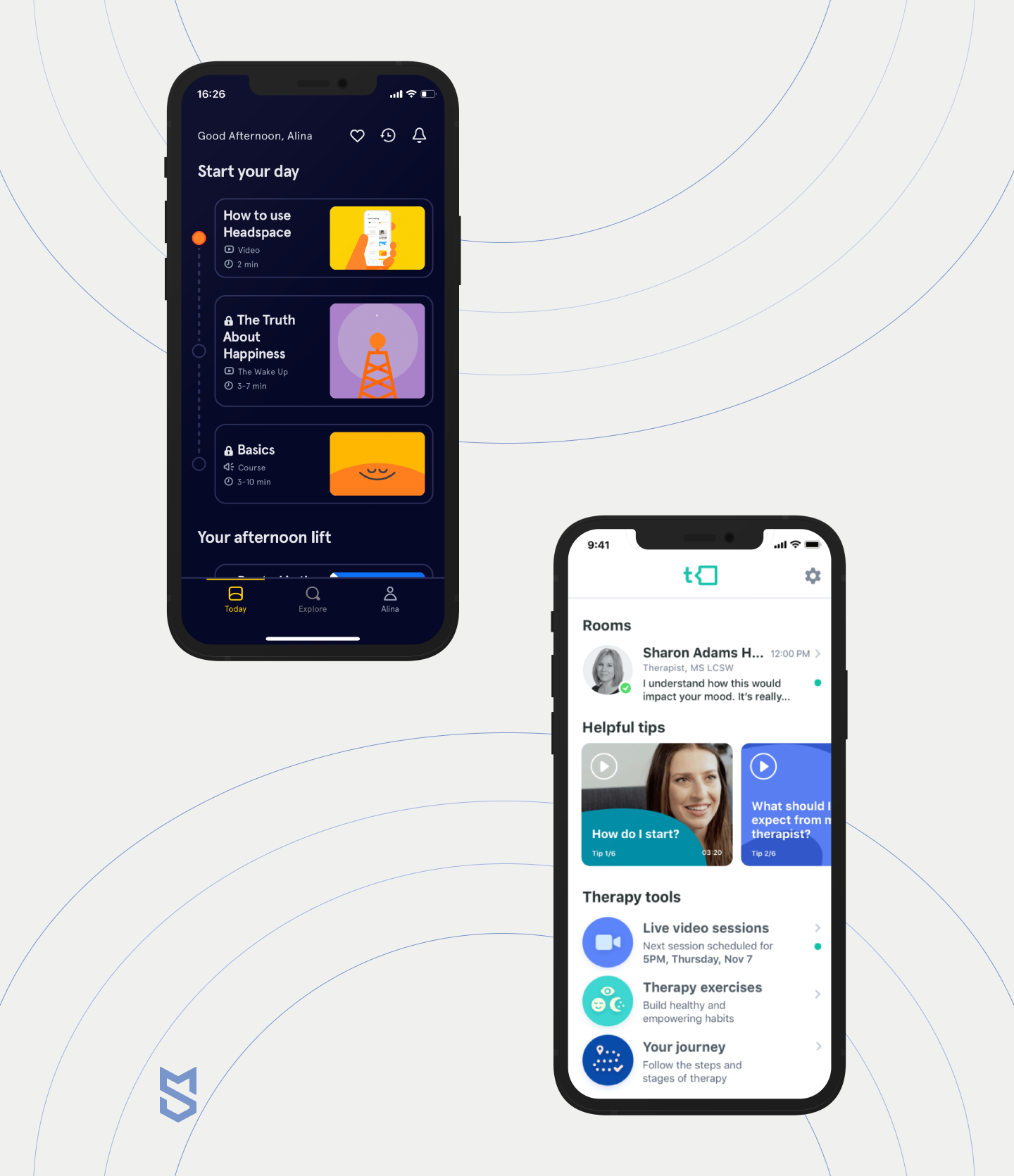
Typically, mental health apps can have:
- text, audio, or video chat feature for communication with therapists
- therapy session scheduling
- progress trackers
- activities to improve mental health, like meditation tools
- support group chats
- patients’ medical health records
Examples: VOS, Headspace, Talkspace
The list of app types we’ve provided in this section is not exhaustive: it goes on and on. There are women’s health apps, educational apps for patients with chronic illnesses, and addiction management apps. And who knows, maybe you’ve got an idea for healthcare application development that doesn’t match any conventional apps out there! So, if you have trouble defining what app type will suit your needs best, feel free to contact us for a free 45-minute consultation.
Healthcare app features that you definitely need to use
The set of features for a healthcare app depends on the app type and its main function. However, there are features that are crucial for most mHealth apps, be it a telemedicine one, a general hospital app, or an urgent care app. Here is a list of them:
| Must-have features for an mHealth application | |
|---|---|
| Sign-up / Sign-in | While in-app registration may require a lot of information from the user, the sign-in process should be quick and seamless. For instance, you can provide an option of signing in via email client. |
| Doctors’ and patients’ profiles | Doctors’ profiles can contain their specialization, details about their education, the healthcare facility they work at, availability, etc. Patients’ profile should contain their medical information, like medication they are taking, medical history, etc. |
| Appointment management | This feature can be available through a calendar where doctors can check their appointments, and the patients can see doctors’ availability and book an appointment accordingly. |
| In-app chat | This feature is helpful for quick communication with healthcare facility managers or directly with a doctor. |
| Video consultations | Since the pandemic made it less safe for patients to have in-person consultations, the appointments that can be done online are now conducted through video calls. This feature helps both doctors and patients save time, and lowers the risk of getting sick after hospital visits. |
| EHR integration | With every appointment or medical procedure, doctors update patients’ treatment history. EHR (electronic health record) is a digital system where all those records are kept. Integrating an EHR into the app is crucial if you want to provide patients with the best care possible. It also makes the job easier for healthcare providers that might treat your patients in the future. |
| E-prescriptions | Since consultations happen online, doctors naturally should be able to prescribe medicine online as well. Another benefit of this feature is that e-prescriptions are harder to forge. |
| Payment gateway | Providing paid medical services requires giving users an opportunity to make in-app payments. It’s best to choose payment gateways that support not just credit and debit cards, but also digital wallets, crypto payments, and other alternative payment methods. |
| Ratings and reviews | Primarily helpful to patients, this feature will assist them in picking a trustworthy professional that meets their needs. |
| Push notifications | These are helpful to both healthcare workers and patients since they can serve as reminders about upcoming consultations and alarm medication reminders. |
Technology stack for healthcare mobile app development
Discuccing the tech stack is an essential part of answering the ultimate question of how to develop a health app.
Choosing the technology to create a health app directly influences how smoothly it will run in the future and how convenient it will be for the users. Here is what the technology stack for your medical application development would look like if you decided to build it with the Mind Studios team:
| Healthcare app development tech stack | |
|---|---|
| Sign-up / sign-in | Facebook API, Google API |
| Chat | Twilio |
| Audio / video calls | WebRTC, RTMP |
| EHR | REST API, GraphQL |
| Payment functionality | Stripe, PayPal |
| Calendar | Google Calendar API |
| Notifications | Firebase SDK, APNs |
| Storage | Amazon S3, Google Cloud Storage |
| Backend | Ruby on Rails, Elixir/Phoenix, Node.js |
| Database | MySQL, PostgreSQL, MongoDB |
| Web app | JavaScript, HTML, CSS, Vue.js, React.js |
| iOS app | Swift |
| Android app | Kotlin, Java |
What to consider before the healthcare mobile application development
In addition to the features and choice of technologies, there are a few more aspects of healthcare app development to take into account. Here, we share a list of the most crucial ones.
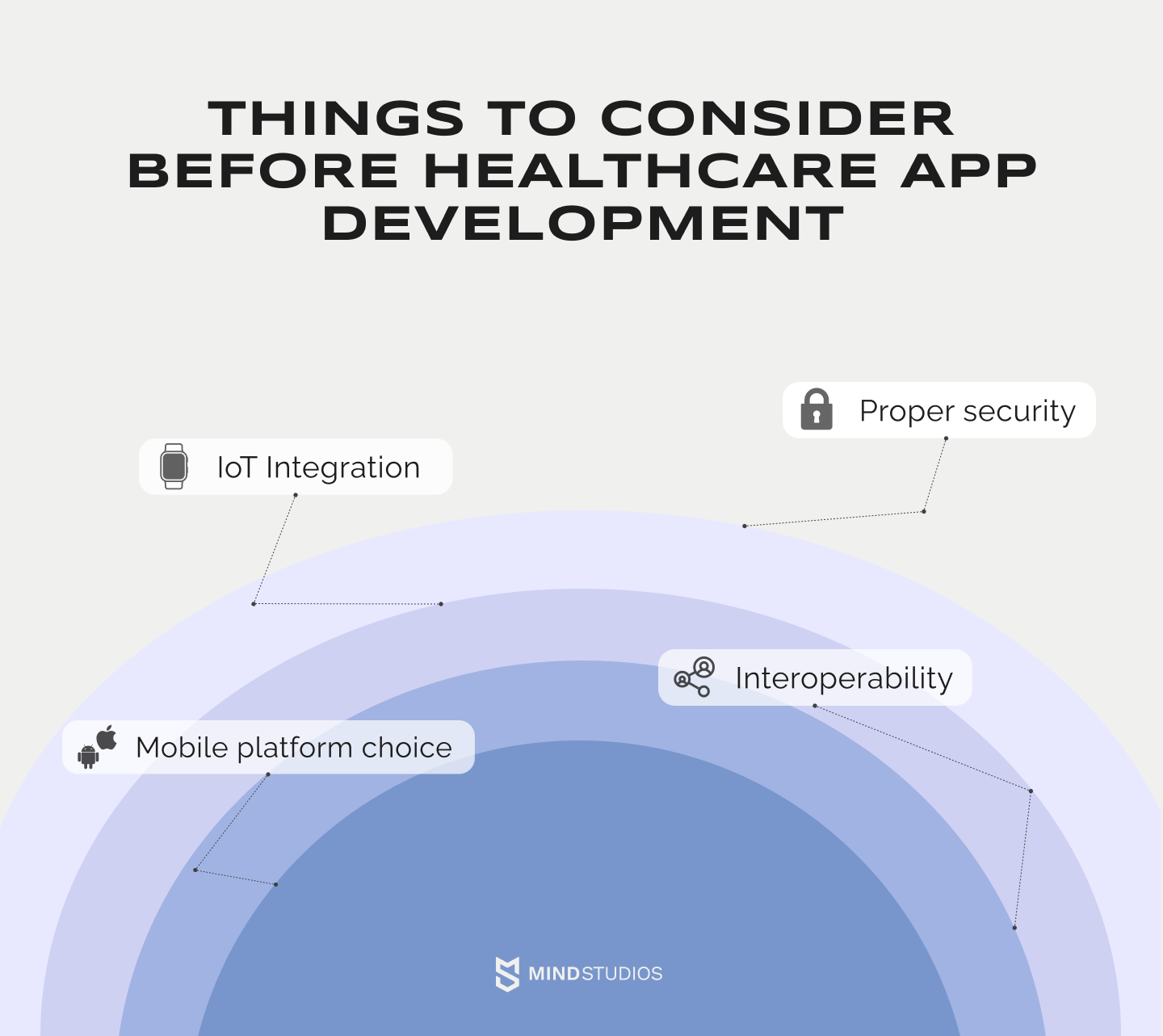
Mobile platform choice
It’s common practice with mobile apps to start with just one mobile platform (iOS or Android) and scale the project along the way. It’s totally acceptable to do so with health apps, like healthy habit trackers or meditation platforms, especially when building an MVP.
However, when it comes to hospital application development, it’s advisable to launch iOS and Android apps simultaneously. The whole point healthcare providers like general hospitals decide to digitalize their medical services is to make healthcare more accessible, and you can’t achieve that by prioritizing one group of patients over another.
Interoperability
Building a healthcare app, especially a medical one, can require integrating it with various medical systems and databases the healthcare provider uses. The interoperability of the app directly impacts how compatible those medical systems and the app will be.
As stated in the IBM article, interoperability in healthcare means timely and secure access, integration and use of electronic health data so that it can be used to optimize health outcomes for individuals and populations.
To put simply, developing a health app with high level of interoperability makes it easier for healthcare professionals to provide medical services: check the patient’s EHRs, order tests, access the results, etc. As a result, this improves the quality and speed of medical care.
So, if you’re making a medical app for both healthcare professionals and their patients, make sure all health systems integrated within your app work as one ecosystem. For this, you will need to use APIs like SMART, the technology that enables building interoperable solutions and syncing them with digital medical systems.
IoT Integration
Tracking daily steps, checking vitals, or monitoring the level of stress requires additional devices like smartwatches and other healthcare tools. IoT (internet of things) integration can help you sync the application with those wristbands.
The main purpose of IoT in healthcare software is to secure remote patient monitoring. To be more specific, it can assist doctors and patients in tracking glucose levels, monitoring heart rate, and even observing how the patient’s depression progresses.
Case in point: IoT has become a helpful tool to those battling Parkinson’s disease thanks to IoT sensors that collect data about the symptoms.
Proper security
Data protection is priority number one when it comes to user-centered healthcare software. In addition to sharing sensitive medical information, your users might also need to make payments through your app. Therefore, if you want to make your customers trust you, it’s best to create a healthcare app that is as secure as possible.
To protect users from data breaches and fraud, consider integrating end-to-end data encryption and multifactor authentication.
In addition, in different countries, there are various legal regulations that protect individuals' personal information, and patients’ data in particular. We cover this issue for those who decide to build healthcare applications in the next section.
Health app regulations to comply with
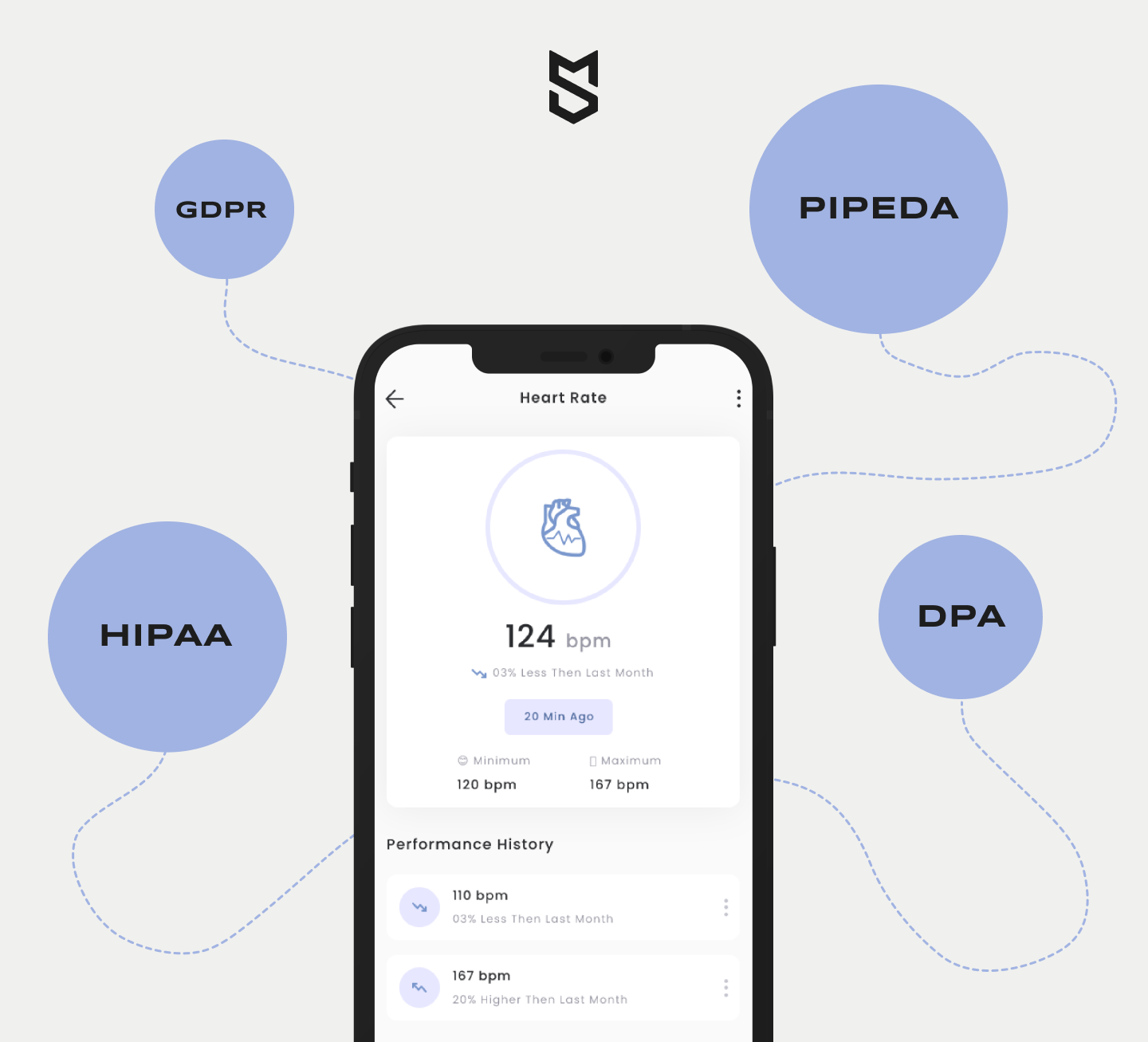
Developing a medical app, like an ER or a general hospital platform, involves dealing with many responsibilities, including various legal and safety regulations. After all, you will be receiving and storing extremely sensitive information from your users.
Here, we’ve gathered a list of regulations your app might need to comply with depending on the regions you’re planning to target. Following these guidelines will ensure that your app is marketed on app stores, as well as protect you from any legal problems.
- GDPR (General Data Protection Regulation) is a regulation in the EU law on data protection and privacy in the European Union and the European Economic Area. It’s considered to be one of the toughest privacy and security laws in the world, and among many types of data, it covers patient health records.
- HIPAA (Health Insurance Portability and Accountability Act) is a USA federal law aimed to protect sensitive patient health information from being disclosed. Apps built for the US market must comply with these regulations (also, learn more about healthcare regulations for AI).
- PIPEDA (The Personal Information Protection and Electronic Documents Act) is the Canadian privacy law that regulates how private organizations collect, use, and disclose personal data. Medical records are considered to be under PIPEDA, therefore, organizations can collect, use or disclose them only after obtaining a person’s consent.
- DPA (Data Protection Act) is the UK law that applies generally to any personal data. It controls how personal information can be obtained and processed, as well as guarantees individuals the right to access their own personal data.
Though there are more regulations, some of them overlap. For instance, if your application is compliant with the USA’s HIPAA, it will also comply with HiTECH, another US regulation on EHR data security. Other examples are Canadian PIPEDA and European GDPR, which are also quite similar.
Healthcare Application Development Steps
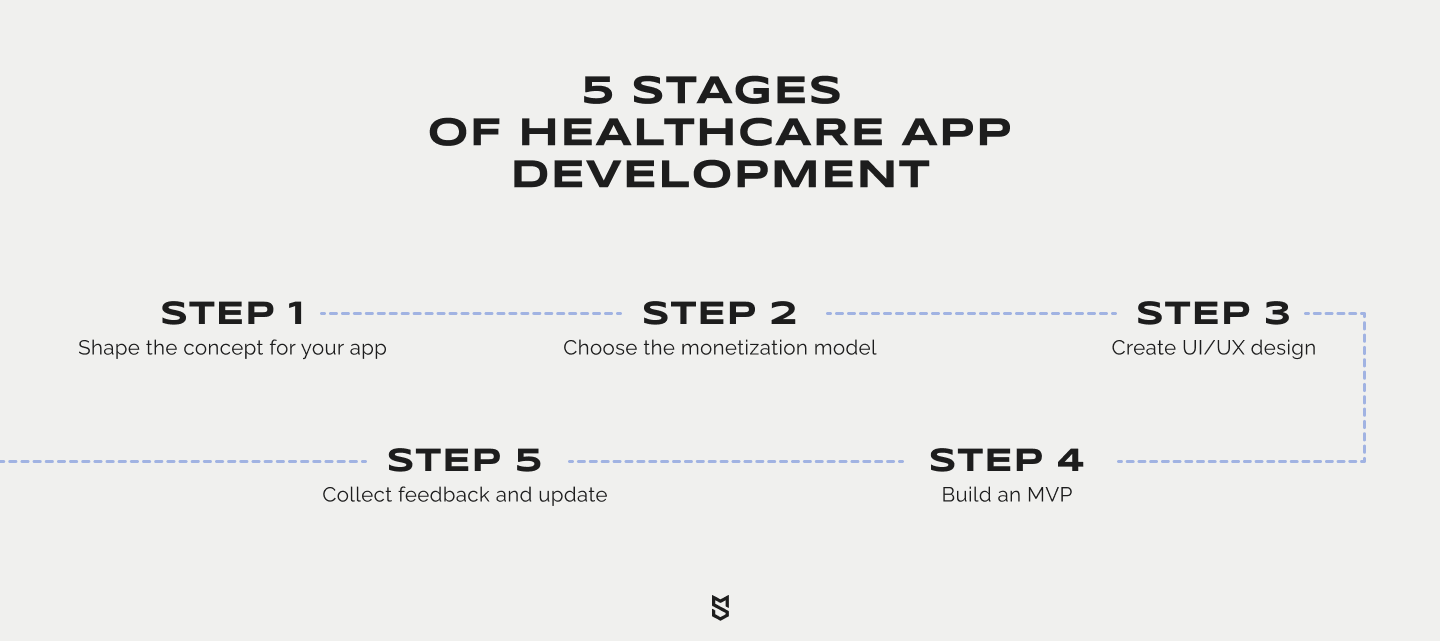
The whole journey of developing a healthcare application can be narrowed down to 5 main stages that you cannot skip if you want to know how to develop a medical app:
- Step 1: Shape the concept for your app
- Step 2: Choose the monetization model
- Step 3: Create UI/UX design
- Step 4: Build an MVP
- Step 5: Collect feedback and update
Step 1. Shape the concept for your app
Why would users download your app and stick with it? That’s the first question you need to answer before you develop healthcare app. To do so, you will need to:
- Define your prospective users (including their age, location, and average income) and study their needs
- Conduct market research and dive into your competitors’ strong and weak points
- Come up with a list of selling points (like app features and additional services) that can win your target audience over
- Define the goals you want the app to achieve and sync them with your budget
All this will help you define what kind of app you actually want to build and come up with a clear strategy for the project.
Step 2. Choose the monetization model
This aspect is pretty simple for healthcare providers who decided to build a healthcare app as another platform to sell their services: they don't need to monetize the app itself as it's only a convenient extra tool. However, for owners of such apps as meditation or healthy lifestyle platforms, the question is a bit more complicated. Basically, there are four main monetization models to consider:
- Freemium model, which means the app is free to use, but some features are available only through in-app purchases
- Subscription model implies that users get access to all or some features only through subscription (usually a monthly, quarterly, or yearly one)
- In-app ads, meaning the app is free to use, but sometimes the session is interrupted by banner, video or other types of ads
- Paid apps are the ones which users have to buy directly from the app store before downloading it. However, it’s mostly suitable for established businesses.
You can choose just one monetization model or combine several.
Step 3. Create UI/UX design
During this stage, UI/UX designers work out the functionality and the visual concept of the app, and, if needed, work on the branding aspect of the platform. The most time-consuming part of this stage is creating prototypes — visual mockups that demonstrate each screen of the app and how the users are going to interact with them.
Each detail here matters, from font and color scheme choices to the placement of the buttons. For mHealth platforms, the most crucial rules to follow are making the app responsive on all devices and making it as quick and easy as possible for users to achieve their goals.
Step 4. Build an MVP
Typically, healthcare mobile app development projects are complex in terms of the technology involved — and therefore, are fairly expensive. But even if you don’t have sufficient funding to implement all of your ideas yet, it doesn’t mean you can’t get the ball rolling. That’s what an MVP is for.
Building an MVP (minimum viable product) means including the most crucial features that fulfill the main purpose of the app. It allows you to launch and collect initial feedback from users faster. And in the meantime, you can fundraise more money to scale the app along the way. This approach is also less risky money-wise since an MVP costs less and lets you check whether your product is at all viable before going further.
Though our team usually goes for an MLP (minimum lovable product) for the first release, each case is different. You can read more about these two options and decide which one suits your needs and resources best.
Step 5. Collect feedback and update
No matter whether you decide to launch with an MVP or an MLP, you will have to address feedback from users quickly and update the app accordingly. After the developers have deployed the updates, the QA engineers once again test the platform to make sure there aren’t any bugs and the project requirements correspond with the results.
How much does it cost to build a healthcare app
There are two major factors that influence the cost of your future app: the complexity of the platform and the choice of the development team.
To integrate all the essential mHealth features we’ve mentioned before, you will need a team of the following specialists:
- 1 project manager
- 1 product manager or business analyst
- 1 UI/UX designer
- 1 iOS developer
- 1 Android developer
- 1 backend developer
- 1 QA engineer
As for the development team options, you can go with an in-house team or hire an outsourced team. The latter option is less expensive, since you can choose a skilled team from any part of the world that fits your budget. For instance, developers from Eastern Europe statistically charge about three times less than those based in the US, while delivering the same results.
As you now know, there are numerous types of healthcare apps. Here, we’ve estimated the cost of building a medical app where patients can schedule appointments, and have video consultations with doctors. The estimate is based on an average Eastern European rate of $45/hour.
| Stage | Time, hours | Cost, USD |
|---|---|---|
| Discovery stage | 80+ | 3,600 |
| UI/UX design | 220 | 9,900 |
| iOS development | 790 | 35,550 |
| Android development | 810 | 36,450 |
| Backend development | 680 | 30,600 |
| Testing | 380 | 15,200 |
| Project management | 360 | 14,400 |
| Total | 3,320 | 145,700 |
Keep in mind that even after the app launches, it will still require funding for maintenance, regular updating, and marketing.
Choosing a healthcare app development team
Partnering with a skilled and trustworthy healthcare app development team is a huge part of your project’s future success. Here are the main steps to making the right choice.
Step 1. Define your needs
Once you know the goals of your project and the specific requirements it has, it will be easier to visualize the kind of team you need, including their experience, expertise, hourly rates, and more.
Step 2. Conduct research
The most convenient platforms to look for a development team are Clutch and GoodFirms. There, you can set up your requirements, like your budget and team’s location, as well as read reviews and check out the companies’ previous projects. Obviously, it makes sense to primarily look for development companies that already know how to create a health app or at least a general wellness platform.
We also recommend seeking referrals and recommendations from your colleagues, fellow industry professionals, or healthcare organizations that have already developed successful apps.
Step 3. Make a shortlist and conduct interviews
Once you evaluate the portfolios of potential candidates, you can make a list of the most suitable ones and set up interviews to discuss the task and see if you make a good match in terms of values and approach to work. If you have IT experts on your in-house team, you can also request a technical interview with prospective developers for your project.
In case you can’t make up your mind between several candidates, you can contact their previous clients and discuss their experience with the teams.
Step 4. Work out a deal that works for you
Before signing a contract with the best candidate, you need to settle on a number of cooperation details, like communication guidelines, risk mitigation strategies, out-of-scope tasks, non-disclosure agreements, post-launch support conditions, and so on.
Choosing the right healthcare app development team is essential to building a secure healthcare app that meets your business goals. And though they might take some time, all these steps are worth the effort.
Mind Studios' experience in healthcare app development
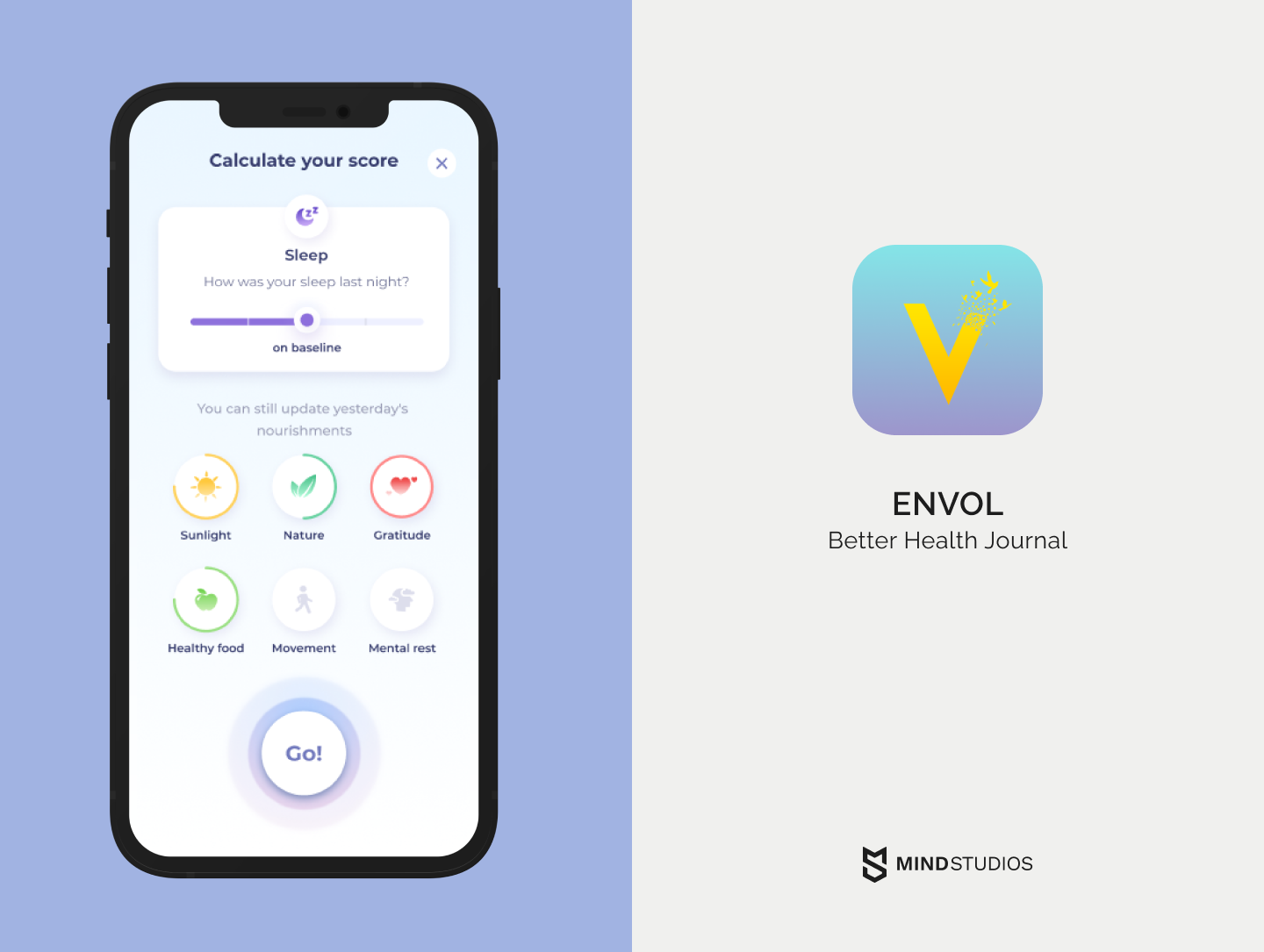
No matter how overcrowded the app market might seem, there is always a way to build a one-of-a-kind platform that will become a hit. Envol, one of Mind Studios’ major projects, is proof of that.
Envol is a mix of several types of apps, including meditation and wellness apps, as well as performance and habit trackers. Created by Julie and Tim, this app is built specifically for assisting people in healing from chronic illnesses and injuries.
The core of this platform is a unique approach called Envol, which is a combination of holistic practices backed up by medical research. These are the same practices that helped Julie heal from a prolonged illness and leave her life in a wheelchair behind.
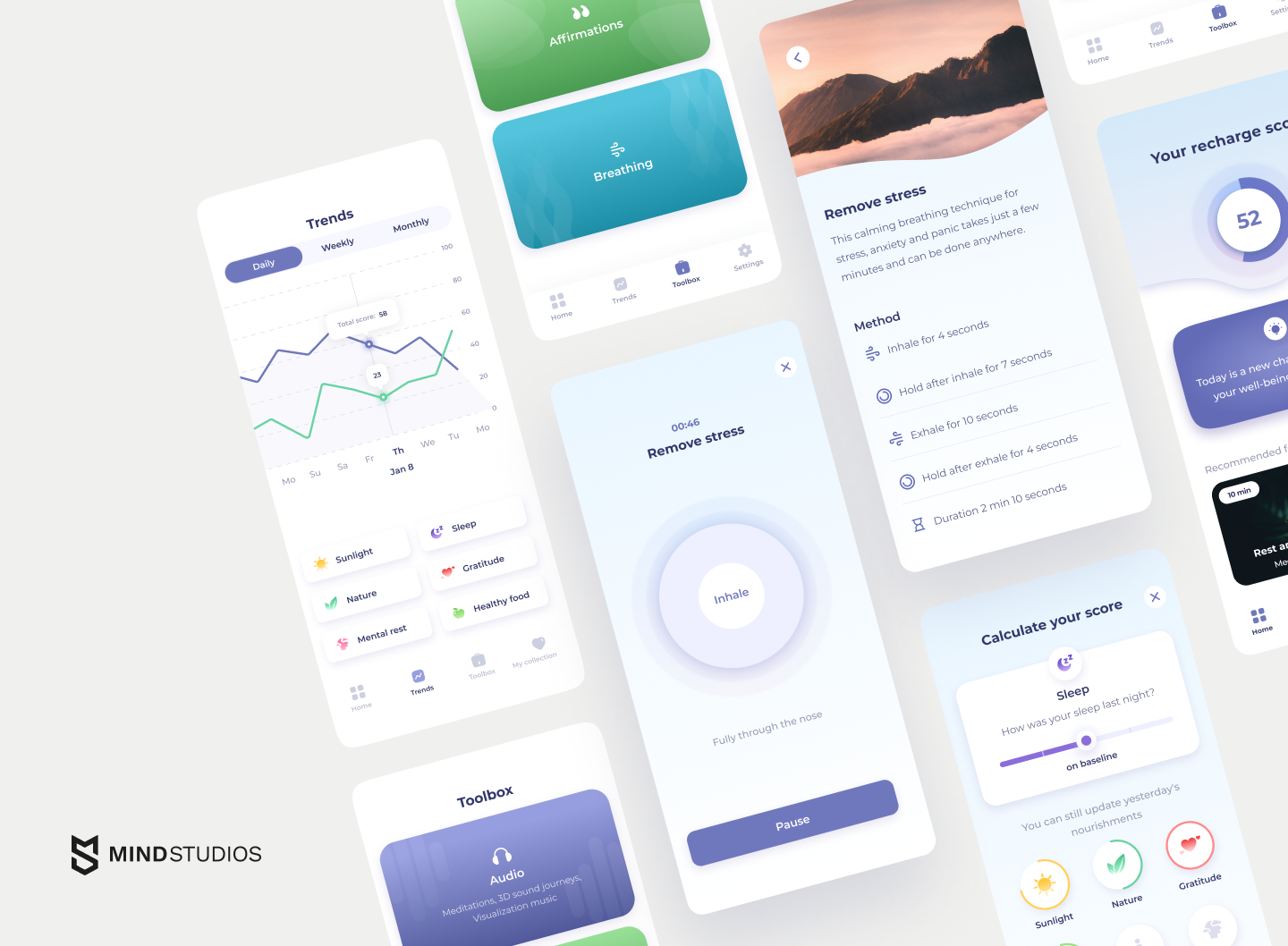
When Julie and Tim first came to Mind Studios, they wanted to update an existing app. After we conducted a business analysis and surveyed Envol’s original users, it was decided to build a brand-new platform from scratch.
One of the major tasks we had to solve was migrating the existing users to a new platform while saving all their data, including tracking stats. We even had to move some data manually, but in the end, users got their tracking and other data without loss.
Constant communication with Julie and Tim helped us all stay on the same page throughout the entire development process and achieve the goals that we’d set at the beginning.
Now, after the launch, we continue supporting the app, updating it with new features, and even assisting Julie and Tim with the tech side of their marketing strategy. We know for a fact that Envol has an even brighter future ahead — and we couldn’t be more proud to be a part of it.
Conclusion
Digitalization of healthcare empowers both patients and medical workers: that’s why they are on board with the process, continually increasing the demand for tools connecting them. What is more, app development for healthcare is a perfect tool to boost preventive care, which can have an immensely positive impact on the global population in the long run.
In this article, we’ve covered various types of healthcare apps, from those aimed at popularizing healthy habits to the ones for medical professionals. If you have any questions on how to make a healthcare app that matches your specific needs — our business development team would gladly arrange a free consultation for you.

